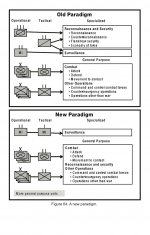I found your article interesting especially from the point of view that we seem to be experimenting with possible solutions in an ad hoc manner. It interests me in that we continue to rely on the ingenuity and "make it work" attitude of our soldiers and junior officers rather than any deliberate process of purposeful analysis. TAPV itself appears to have been a knee jerk reaction to one situation without a proper overarching analysis of what is truly needed over the entire spectrum of combat that the CAF might be committed to.
The cavalry "experiment" reminds me a lot of the artillery's struggle in the '00s to "stay relevant". The armoured corps had the same struggle in the Army's rush to divest all the heavy kit.
As a former, Cold War gunner I can't speak for the specifics of modern kit currently in use (my era encompassed Ferrets and Lynx and ran into the Cougar) so my observations are by necessity general.
@MSmith's observations are bang on. Whoever thought giant barndoors like the LAV and TAPV would work as recce/cavalry vehicles in most terrain was highly optimistic. The low signature of a dismounted team is highly desirable and the potential weapons systems they should have make them highly lethal to pretty much as far out as they can typically see. Their problem is mobility and vulnerability to artillery. (lets face it nothing that will ever deploy with cavalry will be invulnerable to a hit from a tank or ATGM). If you can't change position quickly and shake of the splinters raining down on you, you're toast. Transportation of additional (fairly large) rounds of ATGMs is also needed. You can't always rely on falling back on prepositioned caches in a fluid fight.
Helicopters are pretty much a non starter in the environment we are contemplating now - entirely too vulnerable. Reaching way back in history motorcycles with sidecars were used to effect by the Germans. ATVs are the modern equivalent. Both lack armour and thus entail some risk. While Ferrets did mount SS-11 ATGMs, they are too limited on crew size and Lynx and Cougar go back to the size issue. I liked the CVR(T) family although I thought they were still a bit largish. When it comes to modern existing vehicles, I'm more into the world of the French VBL or the German Wiesel family of vehicles as to size and protection as adequate - not great - but adequate as I think that the key to cavalry in the European environment is 1) don't be seen in the first place, 2) once unmasked, change position rapidly while reasonably protected from small arms and artillery fire while moving, and 3) have enough ammo on board (supplemented by caches) to fight another engagement. Being small and able to hide the vehicle and fight dismounted greatly assists 1). Being small, fast and lightly armoured helps 2) and being just large enough to carry some spare rounds (externally if necessary) helps 3). Anything else becomes a compromise.
I'm not sure if the cavalry should include light infantry or whether the skill set of the cavalryman should simply incorporate light infantry skills as part of their basic trade craft. I tend to go to the latter as mixing the two trades simply sounds like both the infantry and armoured corps looking for ways to "stay relevant". If we had a larger army it wouldn't even be an issue - cavalry would be its own trade/classification.
Besides the vehicles and crews themselves comes the enablers.
In my days as an FOO we rotated around. During the screen or guard some of us would be in DS to them. Once we passed lines our affiliation changed to predesignated battalions and OPs in the main defence and some were prepared to revert to the tanks if a counterattack phase was called for. All that reshuffling is not optimal. Current FOO/JTACs have the LAV OPV which is yet again a barn door when deployed forward. I've quickly come to the conclusion that if the recce force is to become cavalry with its more robust mandate then it needs a dedicated FSCC and dedicated FOOs/JTACs equipped with vehicles that match those of the cavalry and still have the technology required for effective indirect fire support.
I'm a fan of mortars and UCAVs. The two systems have different effects - mortars more anti-personnelish and UCAVs more anti-materielish. I can't see why a mortar platoon can't do both as they systems are
generally needed at different stages of a fight. UCAVs as the enemy approaches, mortars once they shake out and dismount. It just requires a C&C system and vehicles and weapons to easily go either way. IMHO, every battalion and the cavalry element (whether a squadron or regiment) should have an organic mortar/UCAV platoon supplemented by the heavier systems of the artillery which should also have a heavier, longer range UCAV capability.
I'll leave air defence. It's a necessity but we're in such poor shape that it just becomes navel gazing. Suffice it to say that bot anti-UAV and manpad systems should be part and parcel to the cavalry whether organic or as an attachment is immaterial at the moment.
Pioneers? Engineers? Again not too sure to what extent engineer capabilities should be organic to the cavalry or be attached from the brigade's engineer elements. It's absolutely clear that engineering support is needed at certain. The real question is whether that's a temporary use needed solely when the positions are prepared or whether its an ongoing need. If the former than attached for the time needed; if the latter than organic and equipped with vehicles that match the mission. My gut tells me its temporal and therefore ought to be an engineer attachment while needed and then withdrawn for other tasks.
As to the new paradigm - all that I can say is "Jack of all trades, master of none."
Anyway - my $0.02.








